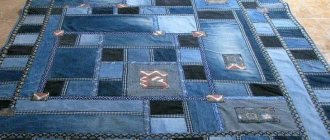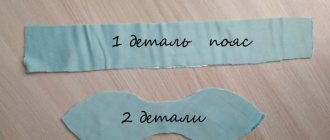Everyone has jeans in their wardrobe; most of us have several pairs. Wide and narrow, classic indigo and faded to a pale blue, finding the pair of your dreams is easy. And if the size, thanks to the abundance of choice and stretch fabric, is not a problem, the length has to be adjusted in every second pair. The article will tell you how to do this correctly, creatively and easily.
How to fix the problem
If you have a sewing machine at home and have the skills to use it, then the process of hemming jeans will not cause problems. If it is not there, and there is also no experience in sewing, then you should carefully follow all instructions and recommendations. In this case, you can hem your jeans yourself without a machine and don’t have to go to an expensive tailor.
Preparing for cutting
Fashionable decor options for shorts made from cut-off denim trousers
The decor distinguishes and highlights the design idea. It’s easy to get a fashionable and stylish item by adding original elements. Decorate the shorts with curly cuts on the back pockets or front, additionally gluing them with non-woven fabric on the reverse side.
The shorts turned out too short - no problem. Cut out stars from the remaining jeans, turn them wrong side out and overlap the edges.
Change the fabric of the inner front pockets to a bright one and it will playfully peek out from under your shorts. Add small details to match the tone.
You can sew lace or fabric with a Provence style pattern onto the back pockets. Such elements will emphasize the fragility and femininity of the owner.
A quick option to change shorts is embroidery with threads or sequins on hot glue. Place the decor on the shorts, place a sheet of paper on top and iron with a hot iron.
Preparation before cutting
Before you start cutting denim trousers, you need to carefully consider how they will be worn in the future. If you plan to wear high-heeled shoes under them, then the fitting should take place in them.
Note! Even a few centimeters can spoil the style and appearance of trousers.
Determining the length requires careful attention. Experts take measurements on the right leg of the trousers and then symmetrically transfer them to the left. But as practice shows, each person has his own characteristics of the silhouette of the figure, so it would be more correct to make marks on each of the legs. You should not adjust the length based on an old pair of pants, even if they are the same model and the same size. This is explained by the fact that each trouser can fit differently when worn.
You might be interested in Full-size moxa patterns and sewing instructions
The process of shortening denim pants
Before hemming jeans manually without a machine, you need to prepare the following tools:
- scissors;
- tailor's pins;
- special needles for denim;
- threads;
- chalk or disappearing marker.
You should also prepare an iron with steam, which will need to be used to iron the product after hemming.
Shortening jeans at home
When you hem trousers yourself, the seam is very different from the factory seam, not for the better - it becomes flat, there is no frayed effect. Knowledge of special techniques allows you to achieve stitch quality that is as close as possible to factory stitching.
Materials
- Chalk or piece of dry soap;
- Tailor's scissors;
- Hammer;
- Threads with needles;
- Ruler;
- Polyethylene;
- Flat brush;
- Acrylic paints.
Step-by-step instruction
- First, put on the jeans and mark the desired length on one leg with chalk.
- The edges of the belt are aligned and secured with tailor's pins.
- The trouser legs are straightened and leveled, secured with pins slightly above the mark.
- Draw a straight line with chalk along the level of the mark; the drawn strip should be perpendicular to the stitched line.
- Select the distance required for the allowance.
- Mark, draw a line, and cut off the bottom cut with scissors.
- Take out the pins.
- Thick places are cut off.
- The sections are folded inwards, basted, folded again and stitched on sewing equipment.
- Stitch the bottom at a small distance.
- Polyethylene is laid on the surface of the table, and jeans are placed on it.
- Using a spray bottle, spray the hemmed bottom of the pants, avoiding getting too wet.
- Hem threads are matched to the color of the denim.
- It is also advisable to use paint that matches the tone as closely as possible.
- Apply color to the stitching area on the back and front sides and allow time to dry.
To create abrasion, take a needle and thick thread and sew stitches 0.5-0.7 cm long along the line by hand. A similar operation is carried out along the bottom edge.
Re-lay the jeans on the table surface and spray with water from a spray bottle. Apply light paint with light brush movements to the front and back edges. Allow time to dry completely, after which the thread is removed.
The jeans look very impressive and have a worn effect along the bottom edge.
Operating rules
In order for the jeans to look beautiful and neat after hemming, it is important to carry out the entire process carefully and in accordance with all the step-by-step recommendations.
Threads for hemming jeans
How to choose threads
Before you start hemming, you need to purchase the appropriate threads. To do this, their thickness should be normal. The most important thing is that they completely coincide with the factory ones.
The threads need to be wound onto a bobbin, it is better if there are two threads at once. The needle thread can be left alone and its color does not matter. When purchasing threads, it is best to have a sample of the cut parts with you.
Features of marking lines for hemming denim trousers
How to mark a hem line for jeans
It is necessary to hem jeans after they are hemmed. If the trousers are wrinkled, they must be ironed first. After this, you can begin to determine the shortening line and hem width.
At home, you can draw a line while standing in front of a mirror. You must definitely do this in the shoes you plan to wear while wearing these trousers. Having decided on the length, you need to tuck the excess inward and pin it with pins. You can also mark the hem line with chalk in one or several places along the back side; there is no need to mark it on the front side.
How to outline and trim jeans
Subsequently, the lapel is marked according to the marks with a solid line in a circle. To do everything accurately, you need to use a ruler. Below the drawn line you need to set aside 3 cm and draw another line. This is where the trouser leg should be shortened. All the above actions are performed on the second side.
You might be interested in this: Patterns and features of sewing skirts with yoke
Fringe as decoration
The raw hem of jeans continues to be a fashion trend. You can make fringe yourself.
The only condition is that the denim fabric must be made of cotton, and the amount of elastane should not exceed 20%. To bend, you only need to have scissors and tweezers on hand.
Work progress:
- Mark the desired length on the product and the fringe area;
- Part of the lower edge of the trouser leg with future fringe is cut into several strips;
- At the next stage, the master’s main task is to carefully pull out the blue threads using scissors or a thick needle, leaving only white ones.
The listed methods for shortening jeans will help you get a beautiful and finished item. You can add your own ideas and unusual solutions.
How to properly shorten
Without a sewing machine, you can shorten your jeans yourself in several ways. The choice will depend on personal preferences and the expected result.
"Bachelor" method
Unmarried men came up with their own quick way to shorten jeans without a sewing machine. This life hack has become popular among the fair sex. After all, thanks to him, nothing needs to be sewn. Its main feature is simplicity and originality. To do this, you must fulfill the following conditions and actions:
- iron the jeans twice to the desired length;
- the second time you need to add one centimeter;
- trim excess material;
- Using Moment glue, coat the first hem from the inside;
- carefully wrap it inside and press it, hold it for several minutes.
All similar actions are performed with the second leg. This old method helps to shorten trousers without hemming and keep them that way for a long time.
Shortening denim pants with glue
Hemming trousers using adhesive tape
Today, special hot-melt adhesive tapes are very popular for manual processing of the bottom of denim trousers. They are made of polyamide and provide a strong adhesive connection, and also guarantee the preservation of the aesthetic appearance of the product for a long time. In this case, the trousers will not be hemmed using threads. Glue the tape using a hot iron. Thus, you can hem both new and old products.
Hemming trousers using adhesive tape
Basic Rules
In order not to be disappointed in the transformation of jeans, you should first take into account the necessary rules. “Experienced” needlewomen give several recommendations that will allow you to achieve the desired result at home.
- If you want to get the actual fluffy edge on your product, first check the composition of the texture. Ideally, the elastane content should not exceed 50%. A fairly coarse material is ideal for creating trendy fringe.
- To fashionably cut jeans in the 2022 season, you first need to decide on the desired length by choosing capris, culottes, breeches, shorts or classic 7/8 legs. After determining your favorite, it will be clear to what point you should cut your boring jeans.
If the expected length exceeds the ankle, you can effectively combine it with high-rise shoes.
Interesting! How to pair a dress with a denim jacket
- If you decide to opt for a trendy raw edge, you can maintain the desired note of carelessness with the help of improvised holes. They can be created using scissors and a grater.
- If you are afraid that the final result will lack symmetry, you can design the bottom in a casual style. Due to the protruding threads, the difference in length will certainly be smoothed out.
Instructions for hemming while maintaining the factory seam
An integral element of clothing is a decorative seam. Many people, having bought jeans that fit them perfectly at the waist, but are not the right length, wonder how to maintain the factory finish.
To do this, you need to adhere to the following procedure:
- determine the length and width of the hem on the wrong side;
- Unfold the item and straighten out all the folds;
- From the intended length, measure upward the width of the hem;
- draw a line parallel to the floor and put 1 centimeter down;
- draw a second line and perform all of the above steps on the other leg;
- cut along the second line;
- take a scrap with a factory stitch and set aside 1 cm from the hem;
- draw lines and cut off excess.
You might be interested in: Quick sewing of a top without patterns yourself
Hemming jeans while maintaining the factory seam
Jeans should be hemmed while maintaining the seam as follows:
- attach details with trim to the trousers;
- align the cuts and chip inside and on the sides;
- carefully sweep away the parts;
- stitch from the factory seam to 1 mm;
- make cutting allowances to the line a few millimeters;
- trim the bottom allowance to 4 mm;
- Iron the edges to the hem;
- Apply a stitch 1 mm from the factory seam and overcast the allowances.
In this simple way you can hem jeans while maintaining the factory seam.
There is no need to bevel the hem line of jeans at the front.
The next step is to accurately mark the hem line on both legs. To do this, first cut off the side marked on the fitting (right). There is no need to bevel the hem line in the front and do not ask the tailor to do this, since the technology for hemming jeans does not provide for this. Next, from the mark that was made along the back of the leg, draw a line (under the ruler) parallel to the factory line of the bottom of the jeans. And most importantly, before cutting your jeans, don’t forget to add an allowance (3-4 cm) to the double hem. Often, this requires “disassembling” the factory hem, clearing the seam of thread and ironing it. You can cut jeans only after marking an additional line, with an increase for the hem of the jeans.
Prices for hemming jeans
In the studio you can inexpensively order processing of the bottom of denim trousers. The cost of the service varies from 200 to 900 rubles.*
Hemming jeans in the studio
Despite the variety of styles and sizes of denim trousers, it is difficult to find a model that would fit perfectly. Problems especially often arise when choosing clothes for a child or a short person. Of course, you can have clothes made to order, but not everyone can afford it. You can solve the problem by hemming the jeans with your own hands. In this case, you don’t even need to have a sewing machine; you can do the trimming and hemming with your own hands.
*Prices are current as of September 2022.
Recommendations for choosing threads and marking
When you need to cut excess fabric to length, it is recommended to visualize this process, because... understanding all the actions makes the work easier. It includes the initial stages:
- search for threads: consider durable varieties, but the thickness of the selected threads should not be thinner or, conversely, thicker than on the product itself; they should also match the color of the pants;
- Marking the material: draw chalk from the wrong side - the line should be smooth and continuous.
To make markings, use more pins/needles. First, you should put on the pants, and for this purpose, select the shoes with which you plan to wear jeans. Then you need to bend the bottom edge, for which pins or needles are used. This will allow you to determine the length of the finished product, and the inner part, which is fixed on the outside, must be cut off.











